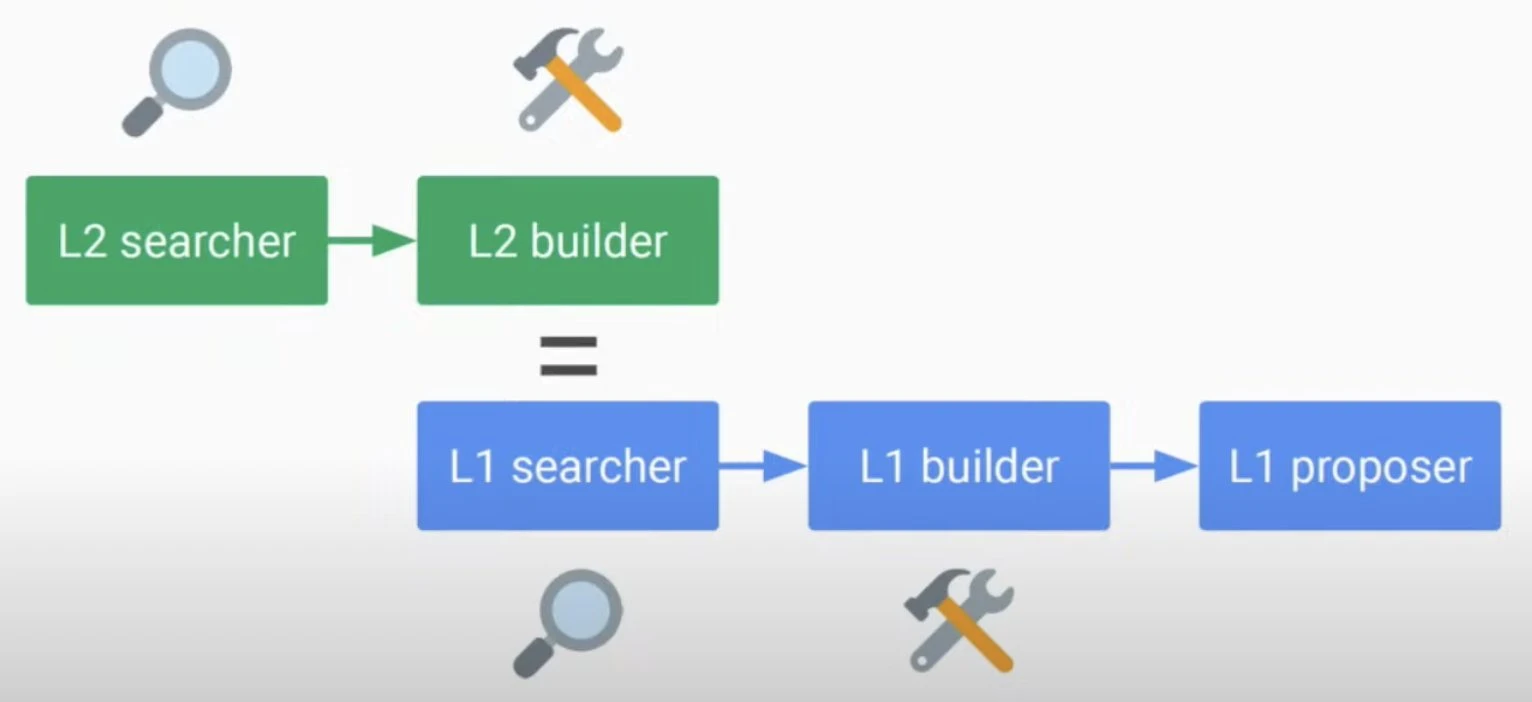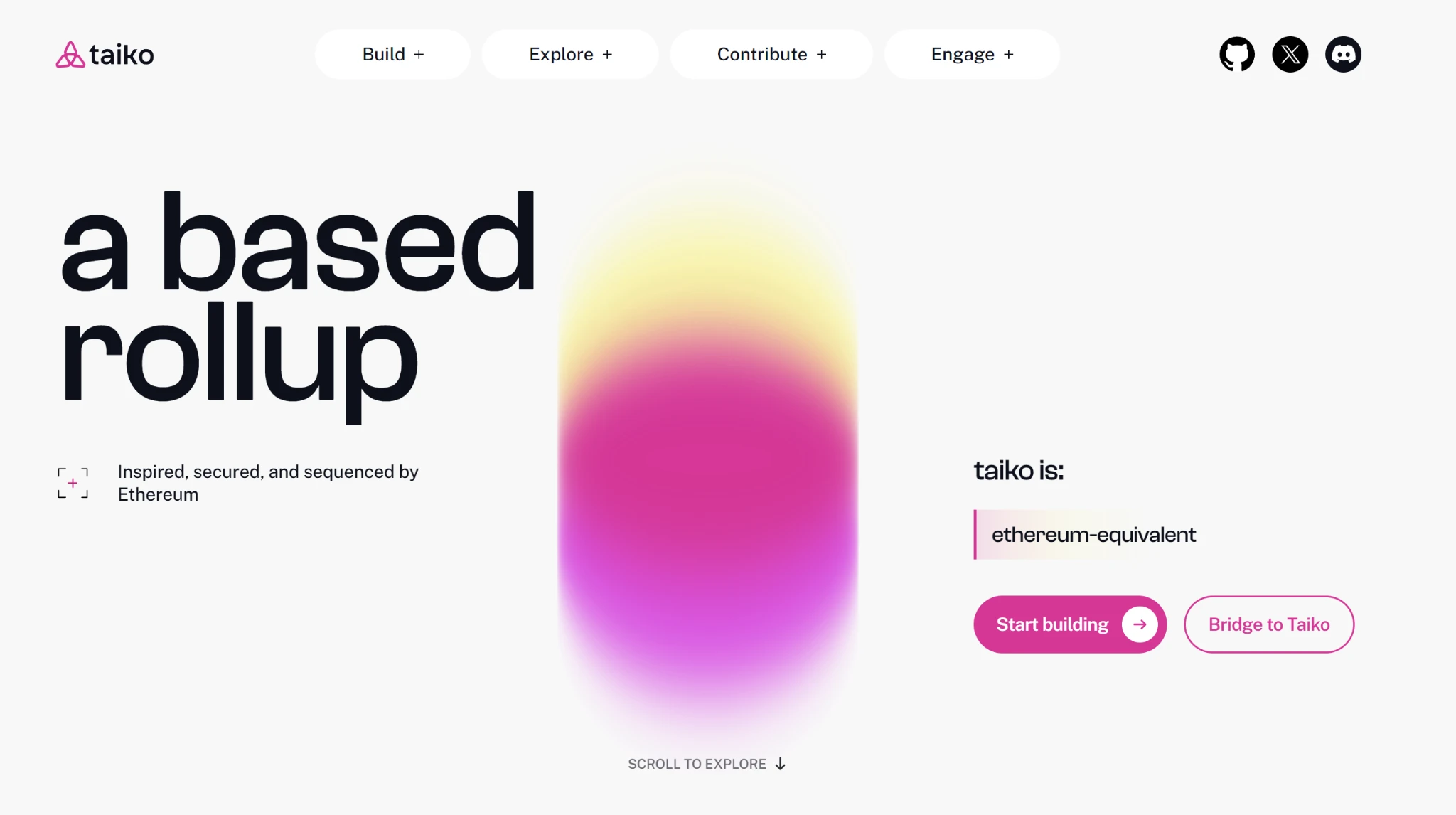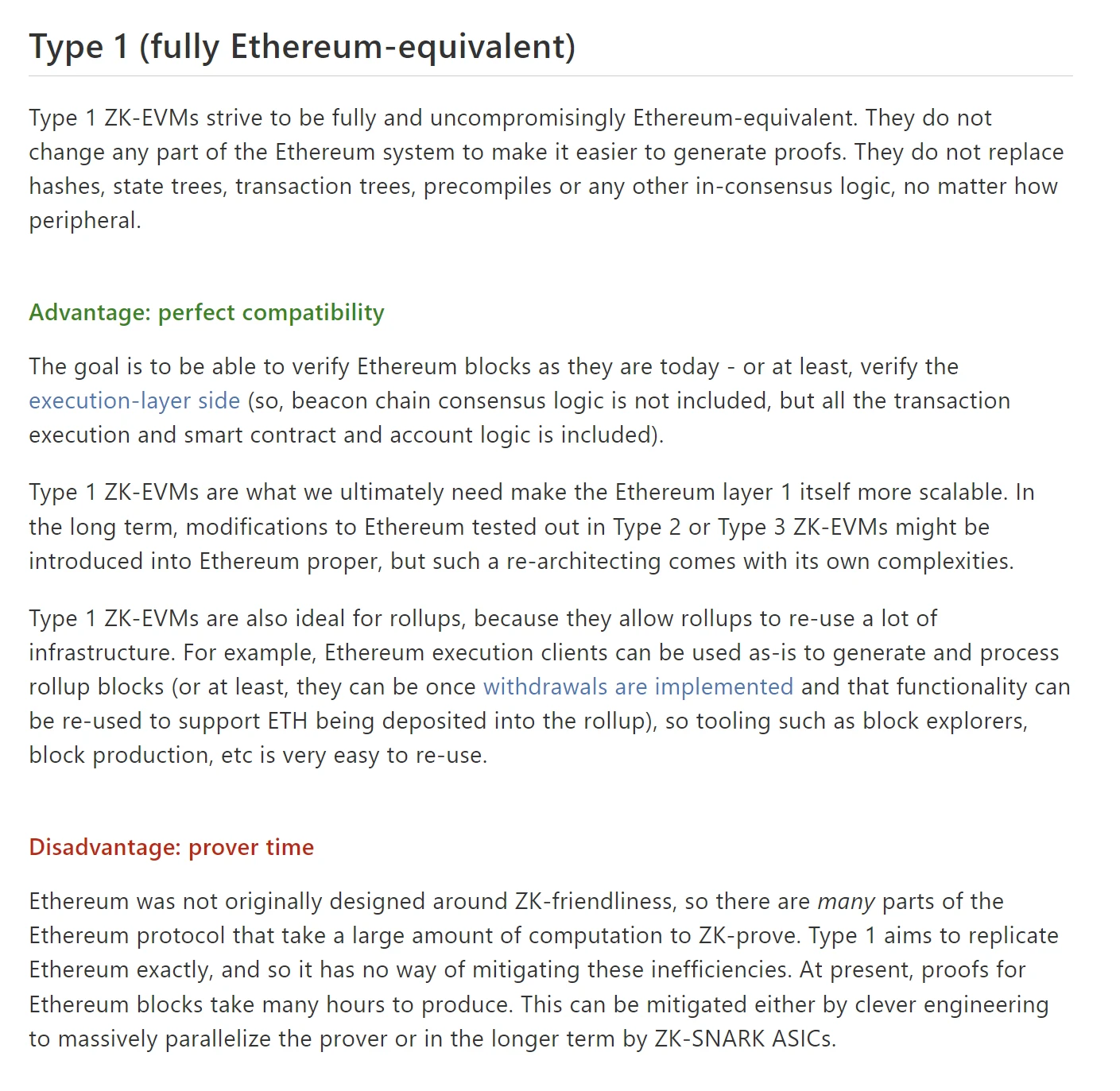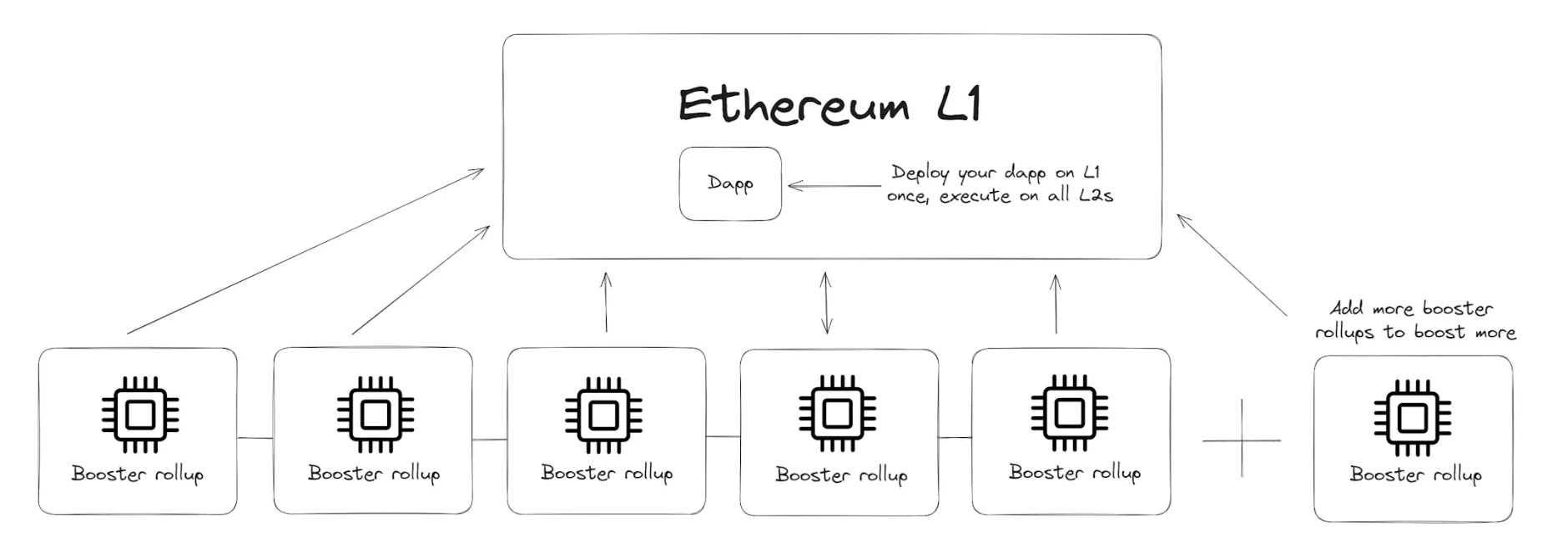From theory to practice: Can Based Rollup realize the L1 sorting-driven Rollup solution?
Original author: YBB Capital Researcher Ac-Core
Preface:
Ethereum works on the principle that each node stores and executes every transaction submitted by the user. In order to expand the entire network, Ethereum adopts the Rollup solution. Simply put, it moves most of the transaction processing to the off-chain (L2), thereby reducing the burden on the Ethereum mainnet (L1) and reducing transaction fees. That is, Rollup = a set of smart contracts in L1 + network nodes in L2, that is, on-chain smart contracts and off-chain aggregators. Its own settlement, consensus and data availability rely on Ethereum itself, and it is only responsible for executing transactions. L2 network nodes are composed of multiple parts, the most important of which is the sorter, but currently the sorters of Rollup are facing the problem of centralization.
Rollup and Sorter
Rollup is a scaling solution for Ethereum (L1) that executes transactions off-chain and packages them in blocks. For each block, Rollup publishes the data required to reconstruct the chain state (as a source of data availability) to the data availability layer, and publishes the proof of correctness of the off-chain execution to the settlement layer (there are two types of Rollup. In the case of ZK-rollup, each block publishes a zero-knowledge proof; in the case of Optimistic rollup, a fraud proof is only published in the event of a dispute). After EIP-4844, when data publishing switches to blobs, this layer may be called the data publishing layer. The smart contract of the Rollup verifies the published proof on L1, and each Rollup will have one or more bridges to enable data transmission between chains as well as deposits and withdrawals.
In the implementation logic of Rollup, the Sequencer is a key component. It is mainly responsible for receiving transaction requests on L2, determining their execution order, and packaging transactions into batches and finally transmitting them to the Rollup smart contract on L1. It plays an important role in improving transaction processing efficiency and reducing costs.
The functions and working principles of the sequencer mainly include four parts.
1. Receiving transactions: The sorter receives transaction requests from users or applications. These transactions are first processed on L2, rather than directly on the Ethereum mainnet;
2. Sorting transactions: The sorter is responsible for sorting the received transactions and determining the order in which they are executed. This process is similar to what Ethereum miners do before packaging transactions into blocks;
3. Packaging transactions: The sorter packages the sorted transactions into batches, which contain summary information of multiple transactions;
4 Submit to L1: Finally, the sorter submits the packaged transaction batch to the Ethereum mainnet (L1) for settlement and data storage. In this way, L1 can verify and store the status updates on L2.
Although Rollup technology provides an effective expansion solution, there are still some problems in the design and implementation of the sorter. The first and foremost is the problem of centralization. Most Rollup projects currently rely on centralized sorters, which are usually controlled by a single entity or a few entities. The intuitive risks they bring are lack of transparency and single point failure.
Putting aside the above rigid explanation, the discussion about the L2 decentralized sorter solution, whether it is the L2 solution of sorting pool node staking directly opened by Metis to the market, or the independent project Espresso solution mentioned in previous articles of YBB Capital, is essentially the distribution of the sorting profit cake and the expectation of future market speculation space, so the correctness of interests and orthodoxy is the key that is difficult to avoid.
Historical Background and Design of Based Rollup
Image credit: @drakefjustin
The concept of Rollup was first proposed by Ethereum founder Vitalik Buterin, whose original idea was to achieve a completely unconstrained Total Anarchy state to allow anyone to expand transactions without restrictions. In view of the above problems with the current sorter, in 2023, Ethereum Researcher: Justin Drake proposed a solution based on Rollups to manage the sorter by Ethereum L1 itself, the content of which is as follows (see extended link 1 for the source):
definition:
“When the ordering of rollups is driven by the base layer (L1), we call them L1-based or L1-ordered rollups. Specifically, L1-based rollups are when the next L1 proposer can collaborate with L1 searchers and builders to permissionlessly include the next Rollup block in the next L1 block.”
advantage:
-
Liveness: Based Rollup enjoys the same liveness guarantees as L1. Please note that the liveness of non-Based Rollup with escape hatches will be reduced (escape hatch is a safety mechanism in Rollup that allows users to safely withdraw assets from L2 back to the L1 main chain when problems occur in the Rollup system. It is similar to an emergency exit);
Weaker settlement guarantees: Escape Pod transactions must wait for a timeout before settlement is guaranteed;
MEV based on censorship: Rollups with escape hatches are vulnerable to adverse MEV from short-term sequencer censorship during timeouts;
Network effects are at risk: Mass exits triggered by sorter liveness failures (such as a 51% attack on a decentralized PoS sorting mechanism) will destroy the network effects of Rollup. Note that unlike L1, Rollup cannot use social consensus to recover gracefully from sorter liveness failures. Mass exits are the sword of Damocles in all known non-Based Rollup designs;
Gas Penalty: Transactions settled via an escape hatch often incur a gas penalty for their users (e.g. due to suboptimal data compression when transactions are not batched).
-
Decentralization: Based Rollup inherits the decentralization of L1 and naturally reuses the L1 searcher-builder-proposer infrastructure. L1 searchers and builders are incentivized to include rollup blocks in their L1 blocks to extract rollup MEV. This in turn incentivizes L1 block proposers to package rollup blocks on L1.
-
Simplicity: Based Rollup sorting is the simplest, even much simpler than centralized sorting. Based Rollup does not require verification of sorter signatures, does not require escape hatches, and does not require external PoS consensus.
Historical note: In January 2021, Vitalik called L1-order-based schemes complete anarchy, which risked submitting multiple rollup blocks at the same time, resulting in wasted gas and work. The current Proposer-Builder Separation (PBS) scheme allows for strictly controlled L1 ordering, with at most one rollup block per L1 block, and no gas waste. When the rollups n+1 block (or n+k for k >= 1) contains a SNARK proof for block n, the waste of ZK-rollup proof work can be avoided.
-
Cost: Based Rollup has zero gas cost — there is no need to verify signatures from decentralized or centralized sorters. The simplicity of Based Rollup reduces development costs, shortens release time, and reduces the exposure of code vulnerabilities. Based Rollups sorting also does not require tokens, avoiding the regulatory burden of token-based sorters.
-
L1 economic alignment: MEV originating from Based Rollup naturally flows to the L1 on which it is based. This flow strengthens L1 economic security and, in the event of MEV destruction, increases the economic scarcity of L1 native tokens. This close economic alignment with L1 may help build the legitimacy of Based Rollup. Importantly, despite sacrificing MEV revenue, Based Rollup retains the option to generate revenue from L2 congestion fees (such as L2 base fees in the form of EIP-1559).
-
Sovereignty: Despite delegating ordering to L1, Based Rollup retains sovereignty. Based Rollup can have a governance token, collect base fees, and can use the proceeds of these base fees when appropriate (such as Optimism to fund public goods).
shortcoming:
-
No MEV Revenue: Based Rollup relinquishes MEV to L1, limiting its revenue to base fees. Counterintuitively, this may increase Based Rollup’s total revenue. The reason is that the rollup landscape appears to be winner-takes-all, and the winning rollup may leverage Based Rollup’s security, decentralization, simplicity, and consistency to achieve dominance and ultimately maximize revenue.
-
Constrained ordering: Delegating ordering to the L1 reduces ordering flexibility. This makes certain ordering services more difficult or even impossible to implement:
Preconfirmation: Fast preconfirmation is not a problem for centralized ordering and can be achieved with external PoS consensus. Fast preconfirmation with L1 ordering is an open problem with many promising research directions, including EigenL, Inclusion Lists, and Builder Bonds.
First Come First Served (FCFS): It is uncertain whether Arbitrum-style FCFS ordering can be implemented on Based Rollup. EigenL may provide an FCFS overlay for L1-ordered Based Rollup.
name:
The name “Based Rollup” comes from its closeness to the base chain (Base L1). This conflicts with Coinbase’s recently announced Base chain, which is a strange coincidence. In fact, Coinbase shared two design goals in their Base announcement:
-
Tokenlessness: “We have no plans to issue a new network token.”
-
Decentralisation: “We […] plan to gradually decentralize the blockchain over time.”
Base can achieve token-free decentralization by becoming a Based Rollup.
Image source: @jchaskin 22
In theory, Based Rollup allows anyone to expand to the Rollup block, and publish the sorted transaction status changes to L1 to extract MEV from L2, so that all sorting and security are provided by Ethereum L1. This can circumvent the external proof-of-stake consensus and the token requirements of a specific Rollup. At the same time, compared to other Rollups that are essential to keep assets safe, the emergency escape hatch function can be removed in the vision of Based Rollup. The process only requires that transactions on the Rollup be completed smoothly while keeping Ethereum running safely.
Taiko Labs on Based Rollup
Image source: Taiko official website
Taiko Labs is the main team developing and promoting Based Rollup, which is Taiko Labs project in Ethereums second-layer expansion solution. Its vision is to solve the scalability problem of the Ethereum mainnet through innovative technologies such as Based Rollup. It has three main features:
1. Completely equivalent to Ethereum’s EVM (Type 1) ZK-EVM: The (Type 1) zkEVM used has full Ethereum compatibility, and developers can seamlessly migrate decentralized applications (dApps) between Ethereum and Taiko without worrying about the risk of smart contract execution failure;
2. Open source: All Taiko source code is publicly available on GitHub and can be viewed, built, or modified by anyone. This open source model ensures that the development of blockchain technology is not limited to the efforts of a small team, but also covers communities and developers around the world;
3. Full decentralization: In addition to ensuring high compatibility with EVM, Taiko is also committed to achieving full decentralization of the protocol. Taiko plans to submit blocks and generate zkPs through decentralized proposers and validators to ensure the decentralized nature of the system.
Taiko strives to build a Type 1 fully Ethereum-equivalent
ZK-EVM, which is the pursuit of complete and uncompromising equivalence with Ethereum mentioned by Vitalik Buterin in The different types of ZK-EVMs (see extended link 2). Its purpose is to be fully compatible with Ethereum to verify Ethereum blocks (at least the verifiable execution layer, excluding the beacon chain consensus but including all transactions, smart contracts and account logic, and will not replace hashes, state/transaction trees and other consensus logic), so compared to other types, Type 1 is the most complex and challenging one to be close to the native solution.
Image source: Vitalik Buterin: The different types of ZK-EVMs
Other core structures:
Competitive Rollup (BCR – Base Competitive Rollup)
It is an innovative blockchain expansion solution developed by Taiko Labs. BCR aims to improve the efficiency and security of Rollup through a competitive mechanism, allowing different participants to freely compete to submit blocks and generate proofs, thereby improving the performance and decentralization of the entire network. The overall summary is as follows.
-
Features
Open competition: Allow any qualified participant to compete to submit blocks and generate proofs. This open mechanism reduces centralized control and improves the decentralization of the network. Competitors win rewards and transaction fees by providing better services;
Efficient expansion: It can effectively improve the efficiency of block generation and verification. Multiple competitors can work in parallel, avoiding single-point bottlenecks, improving transaction processing speed and network expansion capabilities;
Security: The systems ability to resist attacks is improved through a multi-party competition mechanism. Blocks and proofs generated by multi-party competition increase the transparency and security of the system, making it difficult to be controlled or attacked by a single entity.
-
Advantage
EVM Compatibility: BCR is fully compatible with the Ethereum Virtual Machine (EVM), allowing existing Ethereum smart contracts and decentralized applications (DApps) to be easily migrated to BCR without major modifications;
High throughput: Since BCR can process transactions and generate blocks in parallel, the networks throughput is significantly improved, capable of handling higher transaction volumes, reducing transaction costs and delays;
Decentralization: Through decentralized block generation and proof mechanisms, the decentralized nature of the network is ensured, reducing the risk of being controlled by centralized entities.
-
Disadvantages
Increased complexity: System complexity requires complex algorithms and protocols to coordinate block generation and verification among multiple competitors. Smart contract complexity may require additional logic to handle competition results.
Potential problems: Under the competition mechanism of BCR, when multiple competitors calculate and submit blocks at the same time, the fees may rise. Users may face higher transaction fees when using BCR for transactions, especially when the network is busy or the competition is fierce. At the same time, large nodes with abundant resources may have an advantage in the competition, resulting in centralization.
BBR-Based Booster Rollup
Booster is a special participant in BBR. It is responsible for optimizing transaction batches, compressing transaction data and processing multiple transaction batches in parallel. Its actual role is to separate execution and storage, keep L2 execution while L1 remains decentralized, and keep the address of smart contracts on L1 and all BBRs consistent.
At the same time, it also faces challenges such as increased system complexity, resource consumption, and potential centralization. In the future, BBR still needs to be further optimized and expanded to meet the needs of the evolving blockchain technology.
Image source: Taiko Labs
Conclusion
From the overall observation at present, Based Rollup can be regarded as a huge change in the expansion method of Ethereums second layer. The sorting of Rollup is directly entrusted to the first layer proposer, and the separation design of proposer and builder is used to let the first layer perform all sorting roles for Rollup. At the same time, MEV is also expanded, so that L2 searchers can send transaction bundles to L2 builders, who are also L1 searchers, and these complete L2 blocks then become part of L1 blocks, and are finally processed by L1 builders and the Ethereum mainnet.
Whether Based Rollup can be assumed to be the final solution to Rollup remains to be verified, but it is undeniable that it is a major innovation in Ethereums second-layer expansion at this stage, providing a safer and decentralized solution for expansion. If the same thinking is brought into the Bitcoin ecosystem, compared with the native and decentralized VM implemented by Ethereum with strong scalability, its implementation difficulty is understandable, so the entire industry still has a long way to go in solving the problem of truly decentralized expansion.
Extension Links:
【 1 】 Based rollups—superpowers from L1 sequencing https://ethresear.ch/t/based-rollups-superpowers-from-l1-sequencing/15016/1
【2】The different types of ZK-EVMs https://vitalik.eth.limo/general/2022/08/04/zkevm.html
Reference articles:
【1】The game of credit: Rollups controlled by multi-signatures and committeeshttps ://mp.weixin.qq.com/s?__biz =Mzk0OTYwMDM1Mg==mid=2247486544idx=1sn=7a0ee8eb1d32e6ef0bd08354986c0a1fsource=41#wechat_redirect
【2】Taiko Research Report: Ethereum Layer 2 Solution for Seamless Expansion and Full Compatibilityhttps ://www.panewslab.com/zh/articledetails/id09jfto.html
This article is sourced from the internet: From theory to practice: Can Based Rollup realize the L1 sorting-driven Rollup solution?
Related: ZetaChain to distribute 10 million ZETA in XP Airdrop Round 1
The first round of ZetaChain XP airdrop is coming soon. Ecosystem applications can submit a ZETA Rewards RFP by 00:00 (UTC) on July 1, which also marks the beginning of the first distribution of airdrop rewards for applications. The 90-day XP launch event has ended. The first round of mainnet rewards is mainly based on the first XP user snapshot on May 1, 2024. In order to support the continued growth of the ZetaChain network, this airdrop event puts the power in the hands of ZetaChain ecosystem applications to better determine the ZETA rewards that users can receive based on the XP data layer. This approach ensures that airdrop rewards are distributed to the most core users and XP activities , while enabling the entire ecosystem to participate. If you…













